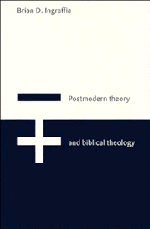Book contents
- Frontmatter
- Contents
- Acknowledgements
- List of abbreviations
- Note on translations of the Bible
- Introduction: postmodernism, ontotheology, and Christianity
- 1 NIETZSCHE'S MOCKERY: THE REJECTION OF TRANSCENDENCE
- 1 The death of God: loss of belief in the Christian God as the cause of nihilism
- 2 Vanquishing God's realm: Nietzsche's abolition of the true world
- 3 Nietzsche on the Judaeo-Christian denial of the world
- 4 The redemptive–eschatological separation between the present world and the world to come in the New Testament
- 5 On redemption: the eternal return or biblical eschatology
- II HEIDEGGER'S FORGETTING: THE SECULARIZATION OF BIBLICAL ANTHROPOLOGY
- III DERRIDA'S DENIALS: THE DECONSTRUCTION OF ONTOTHEOLOGY
- Conclusion: ontotheology, negative theology, and the theology of the cross
- Notes
- Bibliography
- Index
4 - The redemptive–eschatological separation between the present world and the world to come in the New Testament
Published online by Cambridge University Press: 01 June 2011
- Frontmatter
- Contents
- Acknowledgements
- List of abbreviations
- Note on translations of the Bible
- Introduction: postmodernism, ontotheology, and Christianity
- 1 NIETZSCHE'S MOCKERY: THE REJECTION OF TRANSCENDENCE
- 1 The death of God: loss of belief in the Christian God as the cause of nihilism
- 2 Vanquishing God's realm: Nietzsche's abolition of the true world
- 3 Nietzsche on the Judaeo-Christian denial of the world
- 4 The redemptive–eschatological separation between the present world and the world to come in the New Testament
- 5 On redemption: the eternal return or biblical eschatology
- II HEIDEGGER'S FORGETTING: THE SECULARIZATION OF BIBLICAL ANTHROPOLOGY
- III DERRIDA'S DENIALS: THE DECONSTRUCTION OF ONTOTHEOLOGY
- Conclusion: ontotheology, negative theology, and the theology of the cross
- Notes
- Bibliography
- Index
Summary
For God so loved the world that he gave his one and only Son, that whoever believes in him shall not perish but have eternal life. For God did not send his Son into the world to condemn the world, but to save the world through him.
John 3:16–18Do not love the world or anything in the world. If anyone loves the world, the love of the Father is not in him.
John 2:15Nietzsche makes a mockery of the New Testament. He argues that one must read these writings with gloves on (AC 46), but anyone who has read the New Testament with any degree of care must wonder if he read the Bible with something covering his eyes and ears, not his hands.
In an ironic allusion to Jesus' promise that the truth shall set you free, Nietzsche claims that he is the first to be able to interpret correctly the true meaning of Christianity.
Only we, we spirits who have become free, have the presuppositions for understanding something that nineteen centuries have misunderstood … Previous readers were immeasurably removed from our loving and cautious neutrality. (AC 36)
Through an investigation of the “presuppositions” which he brings to his criticism of Judeao-Christianity, I want to unmask Nietzsche's “loving and cautious neutrality” as a hostile and resentful slandering of the biblical understanding of the world.
- Type
- Chapter
- Information
- Postmodern Theory and Biblical TheologyVanquishing God's Shadow, pp. 62 - 87Publisher: Cambridge University PressPrint publication year: 1995



